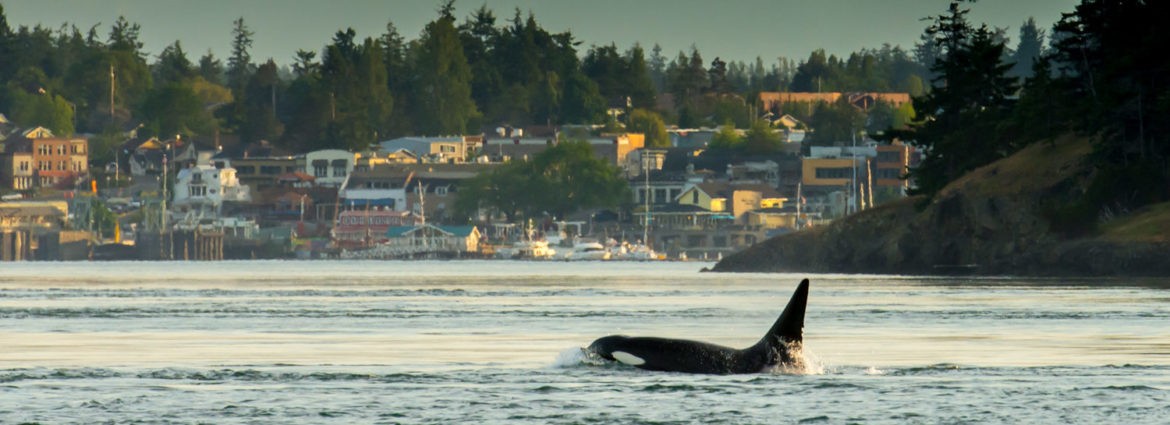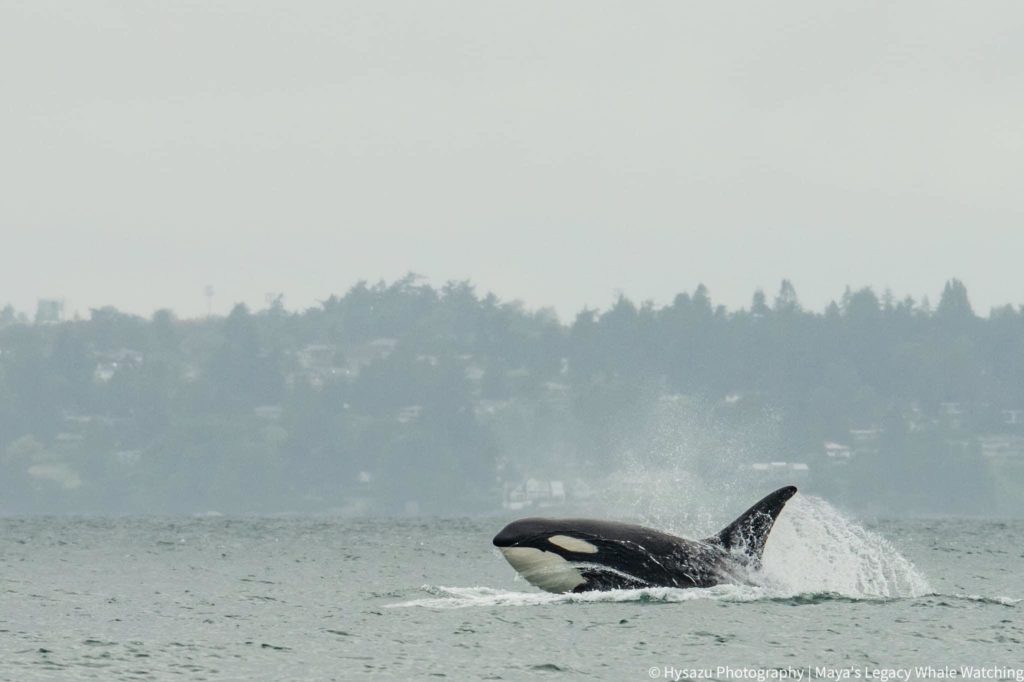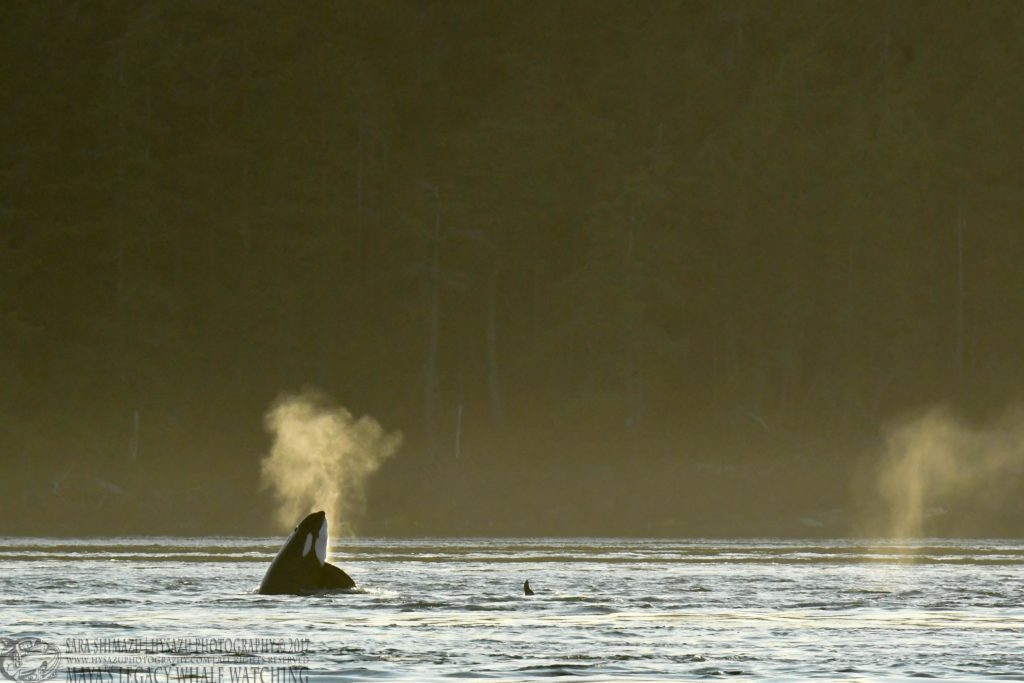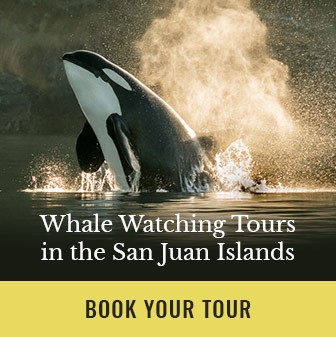Every time we leave the harbor, I remind our guests that we’re entering a wilderness, where anything goes. Although we often have a general idea of what species have been seen on a given day, and what their general location is, I remind people that these are wild species functioning in an intense food web where every animal is constantly trying to find food or avoid becoming food. We never really know what will happen out on the water on a given day. Which makes each trip unique. A glimpse into the lives of whales on that given day, in that given moment.
Last summer, sometime around July, was the perfect example. It was a fortunate day, as the weather was great, the seas were calm, and there had been several confirmed sightings of killer whales in the Salish Sea. We headed north from San Juan Island into Canada’s Gulf Islands, specifically a place called Active Pass. We’d received a report from some of our Canadian friends that there was a lone adult male killer whale swimming through the pass, a common thoroughfare that connects all the coves, bays, nooks, and crannies of the Gulf Islands with the bigger and more exposed waters of the Strait of Georgia. We also knew there were several other matrilines of Bigg's killer whales already in the Strait of Georgia, congregating and socializing together in a very playful, very tactile manner.
What made the lone male orca so interesting, and why I chose to head toward him rather than the larger group of whales, was who he was specifically. The identification assigned to him is T077A, an uncharismatic name but an effective one at keeping track of individual whales. We can identify specific whales based on the unique characteristics of their dorsal fins, saddle patches, and even eye patches. Much like finger prints on humans, no two are the same. If we’re able to take a photograph of the dorsal fin and saddle patch of a whale, we can cross-reference it with the Bigg's killer whale identification catalog, and determine exactly which whale we’re looking at. The catalog contains lots of good stuff, including in what year each whale was born, to which matrline (matriarch-led family unit) he/she belongs, and occasional additional bits of relevant information.
We assumed that T077A was aware that his mom was nearby, and vice versa. A potential family reunion.
T077A is a 24-year old male, born to a whale “named” T077, a 39 year old mother of five. The interesting thing about T077A is that he is most frequently seen traveling alone, without his mother. Which isn’t unheard of in killer whales, but for a species that demonstrates so much orientation toward family and matriarch-based socialization, adult males included, it’s also not the most common sighting. T077A is almost always seen alone, and our team hasn’t seen him with his mother for as long as we can remember.
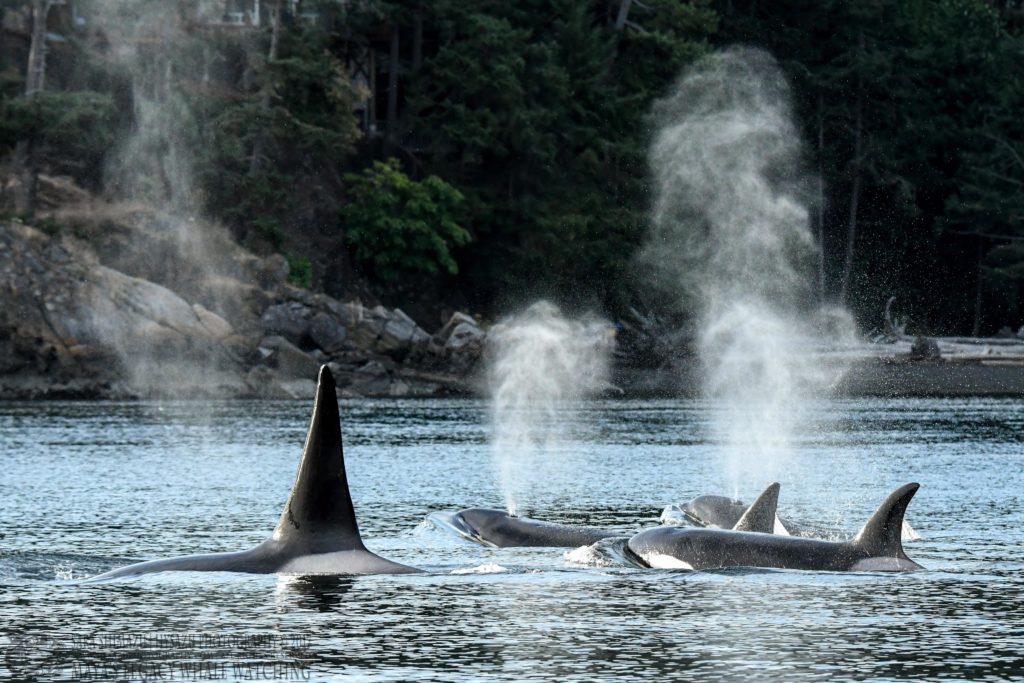
Did he know his family was there, was he hopeful for a reunion? Did he want to see them, embrace them with physical contact? Did he want to celebrate and enjoy a moment with his family?
Of the three other matrilines in the Strait of Georgia that day, one was his mother’s. The matriline known as the T077’s (following the mother/matriarch’s ID). Some other friends of ours who were also on the water had confirmed this, and informed us that they were close to our position. No more than a few miles away. Considering that it’s presumed that killer whales can communicate over distances of five or more miles, we assumed that T077A was aware that his mom was nearby, and vice versa. A potential family reunion.
We came through Active Pass and spotted the solitary, tall dorsal fin. He was on the move, pointed directly at the location where we knew the large gathering of killer whales was. Moving with intention, around six or seven knots (seven or eight miles per hour). As he neared the other whales, he picked up speed. Within two miles or so, he likely doubled his speed, beginning to porpoise (a method of swimming in which whales continuously propel themselves forward so aggressively that they leap out of the water as they’re swimming). His family was nearby. He knew. He wanted to get there quickly.
We couldn’t keep up with his pace, as it is both proper etiquette as well as regulation to maintain a speed no faster than seven knots within a kilometer of whales. But the seas were calm enough that we could observe him picking up the pace from our slower speed and ever-increasing distance. Off he went.
A thousand thoughts raced through my mind. He was obviously excited in some capacity, or he wouldn’t have exerted so much energy to reach his family as much as he was. It was obvious that he knew other whales were nearby, as he pointed directly at them, making as efficient of a line as possible. Did he know his mother was there? Could he recognize her voice as he neared? I assumed so, but it’s impossible to know. If he did know his family was there, was he hopeful for a reunion? Did he want to see them, embrace them with physical contact? Did he want to celebrate and enjoy a moment with his rarely seen family? It was impossible to know, but the speculations abounded.
He eventually stopped porpoising at a distance of roughly 500 meters from the larger gathering of whales. Some fifteen or so in total. We were behind him nearly a half mile, but he’d been easy to track. And when he stopped porpoising, he vanished. No dorsal fin visible, no surfacing for a breath for several minutes. We slowly caught up. Finally we saw a dorsal fin—a large adult male—and we assumed it was our guy T077A. But it wasn’t. It was younger adult male whose family was nearby, a whale known to us as T065A2. He, too, was about 500 meters from the rest of the whales, and we quickly realized why, as T077A’s dorsal fin surfaced near his. The two of them were interacting. This went on for a few minutes, then more. And on and on, for more than a half hour. The two large males swimming together, away from the rest of the social gathering, never getting closer than that perimeter of about 500 meters.
T65A2 on the move. Was he the whale T077A actually wanted to see?
Eventually T065A2 swam back to the big group of whales, including not only his family, but also the family of T077A. But conspicuously absent from the group was T077A. We sighted him off in the distance several more times, and then he disappeared. Swimming away from the gathering of whales. Swimming away from his mother. A haunting feeling.
There is no possible way to know what the interaction between the whales was that day. We can speculate and even anthropomorphize to some degree, but we’ll never truly know. Was there some form of long-standing family dispute? Some unforgiveable offence committed years ago? Did T077A want to reunite with his mother, swimming alongside her saying something along the lines of: “Hi Mom, I’ve missed you. You won’t believe the things I’ve seen all these years. How’ve you been?” Whatever it was that made him swim with such power and intention, it was ultimately interrupted by another young but large, powerful whale. Was T065A2 sent out to intercept T077A on purpose? Was he sent there to “talk” to him, to tell him he should keep his distance? Was he the whale T077A actually wanted to see? Was the whole reason for swimming so swiftly toward the big group of whales just to see one friend and then swim away? Who knows.
Even though we had more questions than answers, it was a great opportunity for our guests to not only witness a unique encounter with whales, but it was also a real-time opportunity to learn about the emotional intelligence of this species.
Anyone who spends time around wild animals is in jeopardy of anthropomorphizing them, but with killer whales it’s even more tempting. And for good reason: their brains—specifically an area of their brains known as the limbic system. As we observed this interesting interaction, and as we began our return trip to San Juan Island, we talked with our guests at length about the limbic system. A region of the brain responsible (whether fully or partially) for things such as emotion processing, learning, retention of long-term memories, motivation, goal-setting, self-control, and empathy. We talked at length about how science is still learning about brains, both humans and whales alike, and our understanding of them is still incomplete. But what we do know so far is that the human brain contains a highly developed limbic system, which is at least partly why we believe humans are so capable of feelings such as joy and bliss, shame and embarrassment, love and heartbreak, anger and forgiveness. How humans can metaphorically “see” their past through the gift of long-term memory, retaining not only important information and lessons learned, but also the ability to refer back to emotions felt decades ago when stimulated by the right song or smell or phrase. How humans can be willing to risk their own life and safety for the sake of another’s—even a stranger’s.
What our guests learned that day was that, believe it or not, the limbic system and associated paralimbic cortex occupy, proportionally, more space in the brain of a killer whale than they do in humans. That, as far as we understand at present, killer whales are every bit as capable as we are of retaining and referring back to long-kept memories, of feeling complex and hard-to-describe emotions, of empathy, goal-setting, and potentially even having enough self-awareness to regulate their behaviors in social situations. That they have the capacity to communicate through language (which it is commonly believed they do, as different ecotypes and populations of killer whales have recognizable and distinctly different vocalizations and patterns). That killer whales can think and feel, refer back to memories and feelings, and communicate. Perhaps they even have the capacity to reflect on memories, and communicate with one another about those reflections. Can you imagine?
Putting that into context, we were given a rare opportunity to witness what was likely a highly emotional moment between family members. Perhaps it was something as simple as “oh boy, there’s my family, I should try to hide out here and hope they don’t see me,” or as complex as the heartbreak one would feel if someone’s mother refused to say hello to her own son.
What they learned was more than academic. It was something deeper,
something you can only get out on the water, in the moment. Something felt rather than memorized.
What our guests learned that day was academic in nature. They learned about the ability to identify specific killer whales through the non-invasive technique of photography and cross referencing. They learned that there are multiple matrilines of killer whales, and even more, they learned that there are multiple ecotypes of killer whales who all have different languages, different diets, different habits and patterns of behavior, and to some degree different methods in which they structure their families. They learned about what foods different types of killer whales eat, and how those different populations can be affected differently by environmental changes such as an abundance of seals vs. a lack of salmon. But what they learned was more than academic. It was more than a lesson on whale identification or surface-level killer whale neuroscience. It was something deeper, something you can only get out on the water, in the moment. Something felt rather than memorized. They learned that whales are individuals. That it’s not just a generic, emotionless whale out in the water, but that it’s a population of hundreds of individuals, each of whom are capable of thinking, feeling, remembering, and communicating. They learned that these animals are likely very well aware of what’s going on around them and are capable of observing changes over time in their environment, remembering those changes, and applying what they’ve learned to their daily lives as individuals, members of a family, and members of a community.
We hope that all of our trips on the water will provide opportunities for our guests to feel some sort of connection with something, be it with the sea, the birds, the seals, the humpback whales, the killer whales. With the world at large. Maybe even with something internal, within themselves. This specific trip no doubt helped people make that connection. I have no doubt that our guests aboard that trip will never forget that encounter between whales, the many behavioral questions left unanswered as to what was communicated and why the solitary male swam away from his mother, alone. And I have no doubt that encounter forever changed the way our guests think about whales—these intelligent, emotional creatures, families, and communities swimming just offshore of where our own daily dramas unfold.
- Captain Daven


